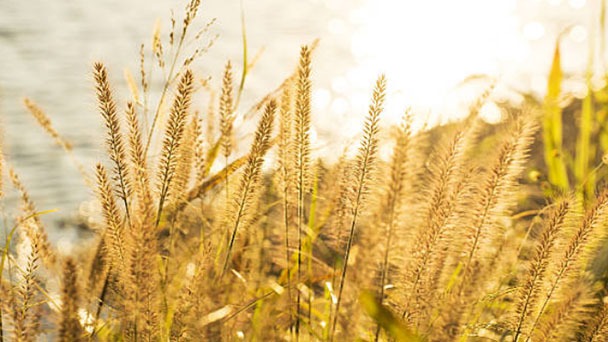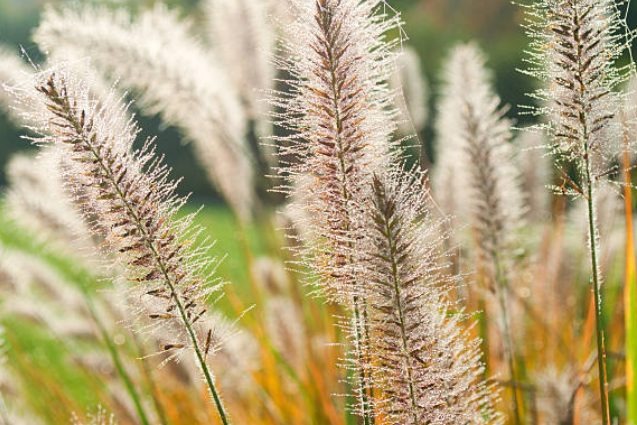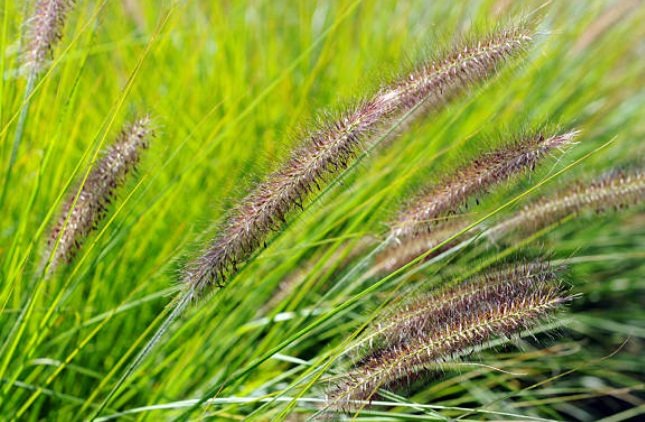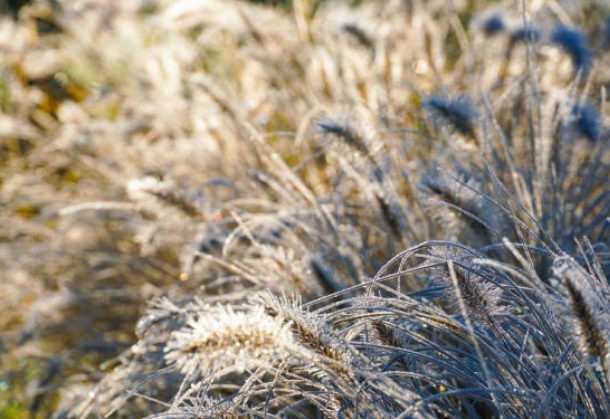Dwarf Fountain Grass Care & Growing Guide 2023
Written by Ivy
Jan 09 2023

The elegant ornamental grass known as dwarf fountain grass (Pennisetum alopecuroides) thrives best in USDA plant hardiness zones 6 through 8 and has fluffy, light-colored plumes. The narrow, cascading green leaves of the grass are topped with eye-catching plumes that resemble foxtails. In the spring, you can see their tiny white flowers, and in the fall, the foliage turns a light auburn color.
Fountain grass is simple to grow. Fountain grass has a wide range of adaptability, like the majority of ornamental grasses. Fountain grass requires little maintenance. Cut back the foliage in the spring before it begins to grow; this can be helpful at times.
Fountain grass does not specifically need fertilizer, but it can be used as growth picks up in the spring. Except in times of drought, established plants do not require routine watering.
Dwarf Fountain Grass Overview
| Botanical Name | Pennisetum alopecuroides ‘Hameln' |
| Common Name | Hameln Fountain Grass |
| Plant Type | Perennial |
| Flower Color | Brown, pink, or purple tiny flowers are sometimes found. The blooms emerge on eye-catching, soft, fluffy plumes that resemble a foxtail. |
| Size When Mature | Between 18 to 30 inches tall and wide |
| Bloom time from | From Late Summer through fall |
| Sun Requirements | Full Sun |
| USDA Hardiness Zones | Between 5 and 9 |
| Soil PH Range | Moderately acidic to neutral: between 5.5 to 7.0 on the pH scale |
| Soil Type | Well-draining and fertile |
| Water Needs | Low |
| Native Area | Asia and Australia |
Dwarf Fountain Grass Care

Size & Growth
With a moderate growth rate, Hameln grows to a height of two or three feet and a spread of one or two feet.
It is best to space the plants 20 to 30 inches apart.
The season progresses, and the plants' long, sharp, arching leaves gradually change from a bright green to a golden brown.
Usually, leaves don't have stems; they just pop up out of the ground.
Flowering & Fragrance
The inflorescence of the plant resembles a bottle brush.
It starts blooming in mid-summer and continues through mid-autumn.
The flower heads undergo a number of transformations from bloom to seed, changing from a light green to a white to a harvest gold hue.
This plant does not reproduce on its own, despite the fact that each seed head contains numerous seeds.
Indeed, seed heads are a good source of food for birds.
Light & Temperature
- This tropical grass prefers warm, relatively sheltered conditions with direct, bright sunlight.
- Light shade won't bother it.
- The ideal temperature range is between 75 and 85 degrees Fahrenheit (24 to 29 degrees C).
- These plants won't begin to sprout new growth until the spring has fully sprung and the soil has warmed up considerably.
- In USDA hardiness zones 5 through 9, dwarf fountain grass is a perennial.
Soil & Transplanting
As long as the soil is well-draining, dwarf fountain grass thrives in almost any kind of soil.
Add lots of organic matter to the soil as an amendment for the best results in terms of natural fertilization.
Plant bare-root materials in the late spring after the soil has fully warmed.
The cold, damp conditions could result in root rot if you plant in the spring too early.
If planting Hameln plants in the fall, make sure to start at least four weeks before the first anticipated frost.
This will give the plants enough time to establish themselves before winter.
Pruning
After the plant has flowered and starts to dry out in the fall or winter, prepare to prune. Because the grass disintegrates and only the flower stalk shafts are left, there won't be any seed heads to search for.
Use string to fasten the dead stems together. Depending on how big and/or how old the grass is, use a hedge trimmer or a pair of pruning shears. All foliage should be trimmed to a height of 3 to 4 inches from the ground. Then, using your hands, go over the stubble to remove any debris that the pruning may have missed.
When you're done, take out all of the clippings to prevent the development of a breeding ground for pests or fungi. The area will appear cleaner and the grass will be better prepared for the upcoming spring by taking the time to clean up.
Fertilizer
To encourage growth, fertilize your Hameln fountain grass with a balanced, slow-release fertilizer in the spring. Alternately, enhancing the nutrient content and maintaining the health of your plant may only require the addition of compost or manure.
Grooming & Maintenance
Check to see if your plants need to be divided and thinned out in the spring when they start to grow.
Also at this time, give the plant a light pruning to promote bushier growth.
It's also a good idea to remove any dead foliage as early as possible in the winter.
How to Propagate Pennisetum Alopecuroides
In the spring, after all threat of frost has passed, dwarf fountain grass can be grown by directly sowing seed into the prepared bed.
Until plants start to grow and become established, make sure to maintain an even moisture level in the soil.
alternatively, divide up the Hameln plant.
As plants mature, their centers start to open, and you can see where the new stems are growing—around the plant's edges.
If you notice this, you should divide the plant into two or more smaller plants.
Typically, division is a task that must be performed every five to ten years.
From Seed
There are some kinds of cultivated Pennisetum – such as purple fountain grass, and P. alopecuroides ‘Cayenne,' ‘Etouffee,' ‘Hush Puppy,' ‘Jambalaya,' and ‘Praline' – that are marketed as sterile. These cannot be grown from seeds.
Given that sterile seed helps to stop unintended spread, this is typically viewed as a benefit. Note that in a few uncommon instances, gardeners have reported buying cultivars that were possibly mislabeled but were actually pollinated and then able to produce (unwanted and self-sowing) fertile seed.
It can be borderline annoying for gardeners who haven't planned for this effect when certain types with fertile seed readily self-seed! An important benefit to be aware of is that these plants don't often become invasive in colder climates the way they can in warmer ones.
Hybrid cultivars won't grow true to seed, so the resulting plants might have unexpected traits.
if you want to grow fountain grass from seed, you may sow in early spring indoors.
Put a fertile seed-starting mixture in 10-by-20-inch trays or pots that are three to four inches in diameter. Plant one to two seeds per pot or, if using trays, space them three to four inches apart. The soil only just touches the seeds.
Following the same spacing guidelines as previously mentioned, you can choose to start seeds outdoors after the last anticipated date of frost in your region, either in pots or in the ground.
In either case, make sure to water the soil consistently up until germination. Within two to three weeks, seedlings should start to appear. The soil surface can be allowed to dry out between waterings once the seedlings have established themselves.
If there is no chance of frost in the forecast, it is safe to transplant the plants outside when they are only two weeks old. Put them outside for just an hour on the first day, then increase the amount of time they spend outside by an hour each day until they are able to spend the entire day outside.
Follow the guidelines below when performing a transplant.

By Division
These plants tend to clump together and spread via rhizomes that grow underground.
Wait until late winter or early spring if you decide to divide your mature fountain grass plants in order to grow new ones.
This will allow enough time for your new plants to establish themselves before the summer heat becomes unbearable.
Your plants should be dormant or just starting to put on new spring growth, and the soil should be warm enough to work in.
Any top growth should first be pruned back to two to three inches above the soil line.
If possible, dig up the entire plant's root ball while working the edges with a shovel. In some circumstances, especially if your plant is very large or old, you might not be able to dig it up completely and will have to work in sections. Feel free to enlist a friend's assistance!
To grow new plants, only divide the root ball's periphery; avoid taking cuttings from the center's old growth. Cut off rooted pieces that are at least three inches in diameter with your shovel.
Replant the parent once your divisions have been made. Divisions can be transplanted using the same procedures as other transplants, to the same depth where they were previously growing in the ground.
Pennisetum Alopecuroides Pest Or Disease Problems
This resilient grass is resistant to deer and typically unaffected by any kind of pest.
The disease poses no threat to plants that are given proper attention, are not overcrowded, and are planted in soil that drains well.
Insects
Almost all creatures, including deer and insects.) leave fountain grass alone. Aphids and mites should be avoided.
Aphids
Aphids (Aphidoidea spp.) cause damage by puncturing the blades to suck out the sap with their tiny mouthparts.
These tiny, frequently green insects may appear harmless, but they have the power to weaken and yellow the foliage.
You can get rid of aphids by pulling them off your plants by hand, aiming a sharp spray from the hose at them, or applying neem oil. Natural predators like ladybugs and green lacewings can also be efficient.
Mites
Mites (Tetranychidae spp.) are similar to aphids in that they are small and difficult to detect. Additionally, the grass blades' juices are sucked by these essentially microscopic arachnids, turning the plants yellow.
Without a magnifying glass, you might not be able to see the mites, but if you know what to look for, one can be useful.
By adhering to the aforementioned instructions for fertilization and watering, you can typically prevent a mite infestation.
Mites prey on plants that become overly dry because they prefer low humidity and dusty environments.
You can get rid of a heavy mite infestation in a similar fashion to how you would deal with an aphid problem, hosing down plants, encouraging beneficial predatory insects to take up residence, or employing an insecticidal soap or pyrethrin product.
Disease
As with pests, maintaining the health of your plants is your best line of defense against the majority of diseases that affect fountain grass. You should be aware of the following illnesses.
Rust
Rust (Pucciniales spp.) is a fungal disease that can target all kinds of ornamental plants, including fountain grasses.
On grass blades, it causes tiny yellow or orange blisters. In some cases, these spots may grow larger and darken, resembling broad, streaky blotches. The blades might even wilt and die back.
The good news about controlling rust is that by getting rid of any damaged plant parts, you can frequently stop its spread.
Watering the plant from the base can frequently stop rust from forming. The development of fungi diseases like this one can be encouraged by excessive moisture brought on by overhead irrigation.
Powdery Mildew
Like rust, powdery mildew is a fungal disease caused by Golovinomyces orontii that results in powdery-looking blotches to appear on leaves. In extreme cases, the entire plant may be covered by these growths.
Applying a fungicide as soon as you notice a problem with powdery mildew may help you eradicate it. But since this is possible by planting in full sun, it is much simpler to avoid.
Fountain grass can tolerate some shade, but dark, humid environments are where fungal issues are much more prevalent.
Once more, watering at the soil level and allowing sufficient space between plants to improve air circulation can both aid in the prevention of this disease.

Is Pennisetum Toxic Or Poisonous?
The grass is not poisonous. The blades are sharp but some types of livestock and wildlife in Africa can eat the seeds, which are a food source for birds.
Planting this grass in areas with high traffic should be avoided because it may cause accidental cuts.
Wear gloves, long sleeves, and eye protection while pruning. Observe that the stubble that has been cut is also sharp.
Suggested Dwarf Fountain Grass Uses
In a small cottage, Zen, or Asian garden, this bird-friendly dwarf plant makes a lovely specimen plant.
It creates a pretty border around a pond and creates a lovely reflection on the surface of the water.
Hameln makes a lovely tall groundcover or border plant. It also looks lovely in dry streambeds, mixed in with perennial flowers, or as an addition to a bird garden.
The Benefits of Fountain Grasses
In the landscape, fountain grasses are highly advised by The Gardening Channel because they are low-maintenance, provide shelter for animals, and offer interest all year long. They can withstand deer, which is even better. In natural, informal landscapes, these grasses provide vertical focal points; however, they can also soften formal landscapes.
Due to its early blooming and suitability for climates with condensed growing seasons, dwarf fountain grass is also well-liked by gardeners. It thrives in fertile, well-drained soil, though it can grow in most types of soil. It doesn't require regular watering unless there has been a drought because it does well in either full sun or light shade.
These low-maintenance grasses require little attention and are not susceptible to diseases or insect infestations. However, they won't survive harsh winters, so if they don't come back in the spring, you might have to replant. Install a physical border around them, such as rocks or wooden planks, to stop them from spreading invasively.Latest Updated
- Benefits of Bugleweed - 7 Science-backed Health Benefits
- Bugleweed Dangers & Side Effects - Is It Poisonous?
- How to Plant Evergreen Trees - What You Should Know
- When to Plant Evergreens - Grow Guide for Evergreen Trees
- 12 Wonderful Evergreen Shrubs for Your Garden
- 12 Popular Evergreen Plants with Pictures for Beginners
- When And How To Prune A Lilac Bush Like a Pro
- How to Grow & Care for Lilac Vine (Hardenbergia Violacea)
- Japanese Lilac Tree (Syringa Reticulata) Care & Propagation Guide
- Shumard Oak Pros and Cons - What to Know
Popular Articles
- Winter maintenance of Antirrhinum Majus
- How to Grow Terminalia Mantaly Tree
- How to Grow and Care for Crossostephium Chinense
- How to grow Antirrhinum Majus in spring
- Peristeria Elata (Dove Orchid) Profile: Info & Care Guide
- Underwatered Snake Plant (Sansevieria Trifasciata) - Signs And How To Fix
- How to Care for Brazilian Jasmine Plant (Mandevilla Sanderi)
- How to Grow & Care for Graptopetalum Purple Delight in Summer
- Rosa Chinensis (China Rose): Plant Growing & Care Tips
- How to Care for Baby Sun Rose (Aptenia Cordifolia)